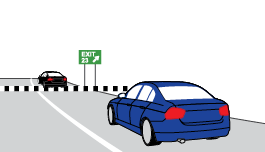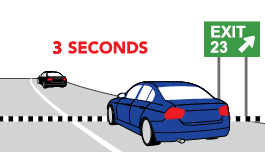6- Looking ahead
 Recommended minimum instructional time: 5 hours
Recommended minimum instructional time: 5 hours
Goal: Teach your teen to develop defensive driving techniques and higher-level visual and anticipatory driving skills before moving on to more complex driving situations. In order to avoid last-second reactions by spotting potential hazards, have your teen always look 20–30 seconds down the road. When they are looking far enough ahead, they will be able to spot hazards early and be well prepared to react to them.
Location: Start on a quiet neighborhood street. Move onto a road with light traffic when your teen is ready.
☐ Skill one – P.D.A. system
The P.D.A. system helps drivers gather, filter, and act on driving information. P.D.A. stands for:
- Perceive: Identify events in the scene that are relevant to you as a driver. For example, you may perceive a vehicle pulling out in front of you.
- Decide: Make decisions based on the information you perceive. For example, you may decide to slow down to avoid colliding with the vehicle that just pulled out in front of you.
- Act: Apply the action to our decision! For example, lift your foot off the accelerator and apply the brake.
Have your teen use commentary driving as they practice the P.D.A. system. As they drive, ask them to verbally describe their thoughts, intentions and actions in order to perceive potential risks, make decisions about the problems these risks could cause and what they would do to minimize the risks (choose alternative path or change speed), then act on their decision.
☐ Skill two – stopping-distance rule
Teach your teen the stopping-distance rule, for the safest distance to stop behind another vehicle. When your vehicle stops, you should be able to see the rear tires of the car in front of you. Any closer is too close.
☐ Skill three – three-second rule
Teach your teen the three-second rule for the appropriate following distance when driving behind other vehicles. The three-second rule is an important safety measure designed to give drivers enough time to safely steer or brake to avoid problems that occur in front of them on the road.
- Start counting when the rear bumper of the vehicle in front of you passes an object.
- Count “one thousand ONE, one thousand TWO, one thousand THREE.”
- Your front bumper should not pass that same object before you’ve reached “three.”
Have your teen practice the three-second rule at least 10–12 times, counting out loud to check whether their following distance is appropriate.


Your front bumper should not pass before you’ve reached “three.”